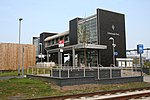National Collection of Aerial Photography
The National Collection of Aerial Photography is a photographic archive in Edinburgh, Scotland, containing 26 million aerial photographs of worldwide historic events and places. From 2008–2015 it was part of the Royal Commission on the Ancient and Historical Monuments of Scotland and since then it has been a sub-brand of Historic Environment Scotland. Many of the aerial reconnaissance photographs were taken during the Second World War and the Cold War, and were declassified and released by the Ministry of Defence. The collection also contains over 1.8 million aerial photographs of Scotland, during and in the years after the Second World War, as well as post-war Ordnance Survey, and over 10 million images of international sites as part of The Aerial Reconnaissance Archives (TARA). The collection contains both military declassified and non-military aerial photographs from over a dozen different national and international organisations. NCAP’s historical aerial photography is primarily used to locate unexploded Second World War bombs by European bomb disposal companies and in historical, archaeological and climate change research. It is also used for documentaries and dramas on television and in film.
Excerpt from the Wikipedia article National Collection of Aerial Photography (License: CC BY-SA 3.0, Authors).National Collection of Aerial Photography
Bankhead Way, City of Edinburgh Sighthill
Geographical coordinates (GPS) Address Nearby Places Show on map
Geographical coordinates (GPS)
| Latitude | Longitude |
|---|---|
| N 55.923611111111 ° | E -3.2988888888889 ° |
Address
Bankhead Way
EH11 4FB City of Edinburgh, Sighthill
Scotland, United Kingdom
Open on Google Maps





